4-7 Understanding how our planets formed around the Sun suggests that planets around other stars are common
If planets formed around our Sun, have they also formed around other stars? That is, are extrasolar planets orbiting distant stars just as our planets orbit the Sun? Although just a few years ago astronomers were not entirely sure that planets actually exist around other stars, today we have several lines of evidence convincing us that planets are common around other stars. To appreciate how remarkable these discoveries are, let’s consider the process that astronomers go through to search for extrasolar planets.
Directly Photographing Extrasolar Planets
 Go to Video 4-3
Go to Video 4-3
It is very difficult to make direct observations of planets orbiting other stars. The challenge is that planets are small and dim compared with stars; as seen by an alien astronomer far from our solar system, at visible wavelengths the Sun is 109 times brighter than Jupiter and 1010 times brighter than Earth. A hypothetical planet orbiting a distant star, even a planet 10 times larger than Jupiter, would be easily lost in the star’s glare as seen through even the largest telescope on Earth. Despite these technical challenges, astronomers have been able to fine-tune telescopes to photograph, for the first time, a few planets visible orbiting distant stars. The first planets photographed are shown in Figure 4-18. The dramatic “first family” pictures of planets beyond our solar system are shown in Figures 4-18a and 4-18b, which were taken by the Gemini Observatory near the summit of Mauna Kea in Hawai’i. Figure 4-18c was taken by the Hubble Space Telescope and shows the motion of extrasolar planet Fomalhaut b. By 2013, about 30 planets beyond our own solar system have been discovered this way.
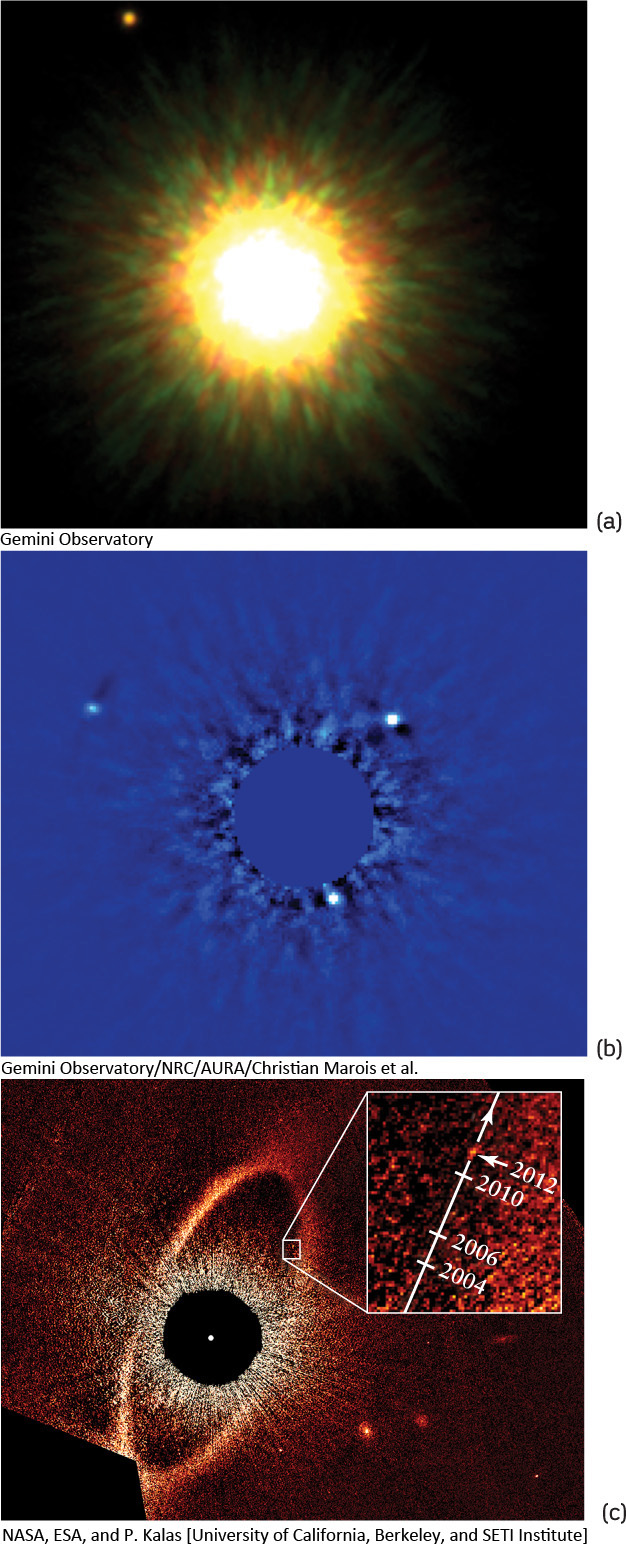
We have always suspected that planets might be a common by-product of the formation of stars when giant clouds of dust and gas collapse under gravity into a star and planetary system. The photographs of actual extrasolar planets orbiting other stars are a tremendous vindication of our theory of star and planetary system formation. It would also tell us that our own planetary system is not unique in the universe. Because at least one planet in our solar system—Earth—has the ability to support life, perhaps other planetary systems could also harbor living organisms.
106
COSMIC CONNECTIONS Formation of the Solar System
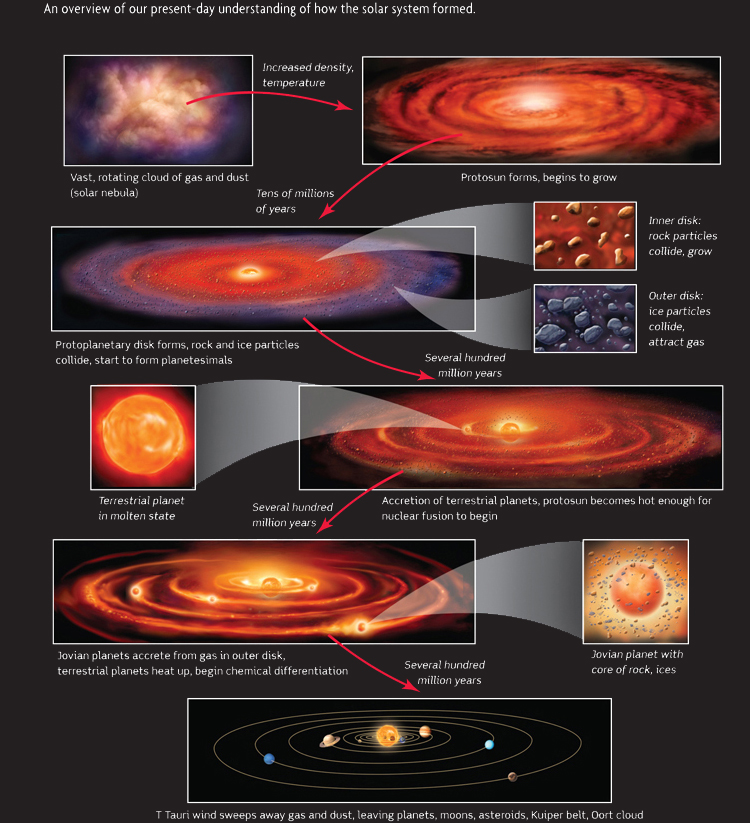
107
Looking for Transiting Planets
The process of finding exoplanets by directly photographing them is an extremely difficult and time-consuming process. In other words, it isn’t very efficient. Instead, the vast majority of planets are found by indirect methods. One of the most surprisingly useful is called the transit method. This method looks for the rare situation in which a planet comes between us and its parent star, an event called a transit (Figure 4-19). As in a partial solar eclipse (Section 1-6), this causes a small but measurable dimming of the star’s light. If a transit is seen, the orbit must be nearly edge-on to our line of sight. As of May 2013, 308 extrasolar planets have been positively identified using ground-based telescopes. But that’s not all. Using the NASA Kepler space observatory, a space telescope specifically designed to look for transiting extrasolar planets, another 865 extrasolar planets have been positively identified, and another 2781 highly likely candidates have already been identified since its launch in 2007. Because only a small fraction of exoplanets might have orbits that line up the exoplanet precisely between their host stars and Earth, causing an observable transit, astronomers now estimate that there could be as many as 17 billion Earth-sized exoplanets in our Milky Way Galaxy alone.
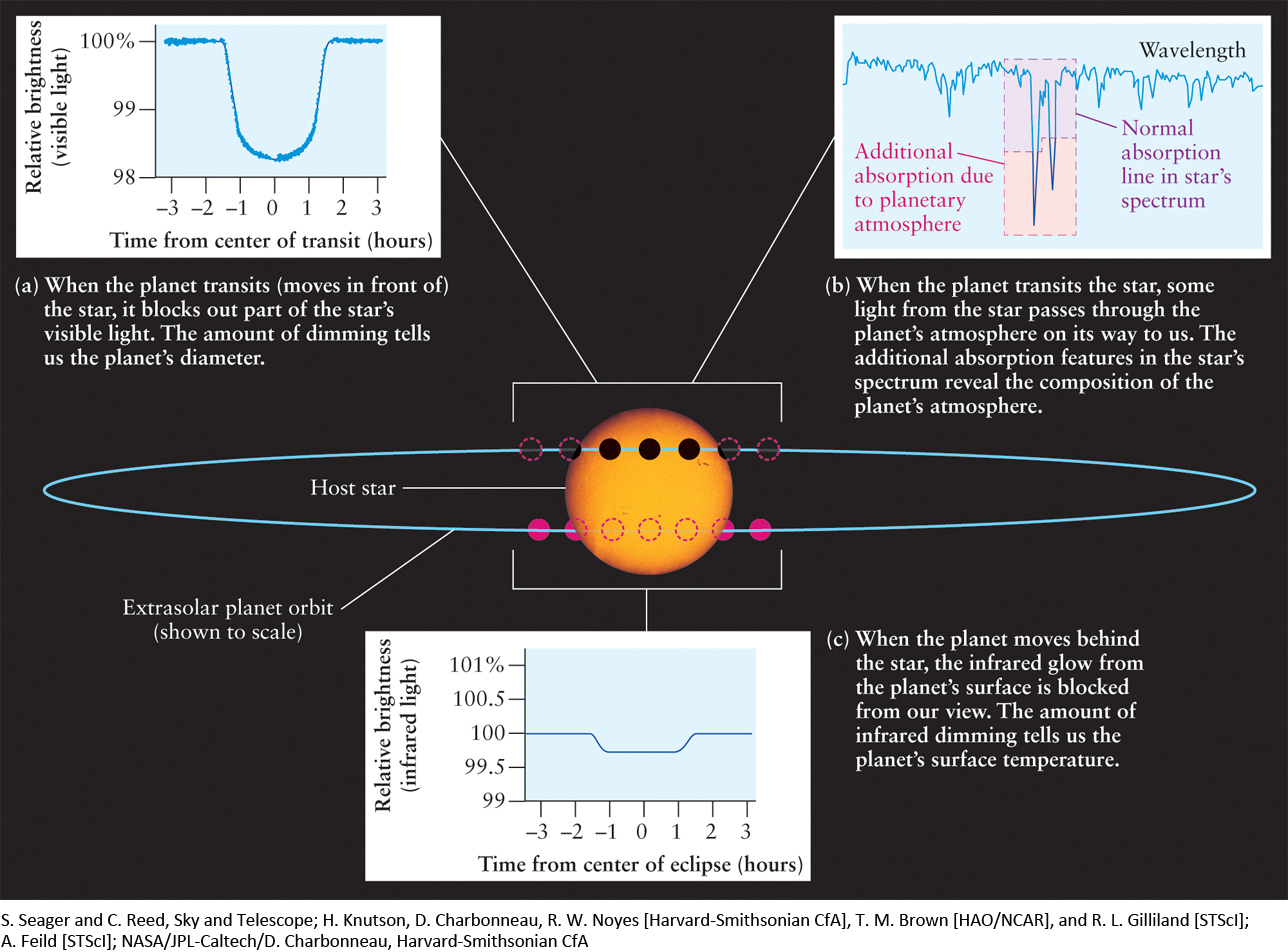
In addition to detection, there are at least three benefits of the transit method. One, the amount by which the star is dimmed during the transit depends on how large the planet is, and so tells us the planet’s diameter (Figure 4-19a). Another benefit is that a star’s light passes through the planet’s atmosphere while it is transiting and certain wavelengths are absorbed by the atmospheric gases. This absorption affects the spectrum of starlight that we measure and thus allows us to determine the composition of the planet’s atmosphere (Figure 4-19b). Finally, with an infrared telescope it is possible to detect a slight dimming when the planet goes behind the star (Figure 4-19c). That is because the planet emits infrared radiation due to its own temperature, and this radiation is blocked when the planet is behind the star. Measuring the amount of dimming tells us the amount of radiation emitted by the planet, which in turn tells us the planet’s surface temperature.
Measuring Stellar Doppler Shifts
The most powerful method available to astronomers for finding and confirming exoplanets is to search for stars that appear to “wobble.” If a star has a planet, it is not quite correct to say that the planet orbits the star. Rather, both the planet and the star move in elliptical orbits around a point that is the center of mass. As an example, consider that the Sun and Jupiter both orbit their common center of mass with an orbital period of 11.86 years. (Jupiter has more mass than the other seven planets put together, so it is a reasonable approximation to consider the Sun’s wobble as being due to Jupiter alone.) Jupiter’s orbit is about 5 times the Sun-Earth distance, 7.78 × 108 km, while the Sun’s wobble is quite small, just 742,000 km, but detectable. The Sun’s radius is 696,000 km, so the Sun slowly wobbles around a point not far outside its surface. If alien astronomers elsewhere in the Galaxy were to detect the Sun’s slight wobbling motion in response to its gravitational attraction with Jupiter, they could tell that there was a large planet (Jupiter) orbiting our Sun. They could even determine the planet’s mass and the size of its orbit, even though Jupiter is small enough that it would be seemingly invisible.
Planets orbiting other stars appear to be quite common in our Galaxy.
108
Detecting the wobble of other stars is not an easy task, and we rarely actually see a distant star wobble back and forth because of an orbiting planet pulling on it. Instead, astronomers use the radial velocity method (Figure 4-20). This is based on the Doppler effect, which we described in Section 2-5. A wobbling star will alternately move away from and toward Earth. This will cause the dark absorption lines in the star’s spectrum to change their wavelengths in a periodic fashion. When the star is moving away from us, its spectrum will undergo a redshift to longer wavelengths. When the star is approaching, there will be a blueshift of the spectrum to shorter wavelengths. These wavelength shifts are very small because the star’s motion around its orbit is quite slow. As an example, the Sun moves around its small orbit at only 28 mi/h (45 km/h). If the Sun were moving directly toward an observer at this speed, the hydrogen absorption line at a wavelength of 656 nm in the Sun’s spectrum would be shifted by only 2.6 × 10−5 nm, or about 1 part in 25 million.
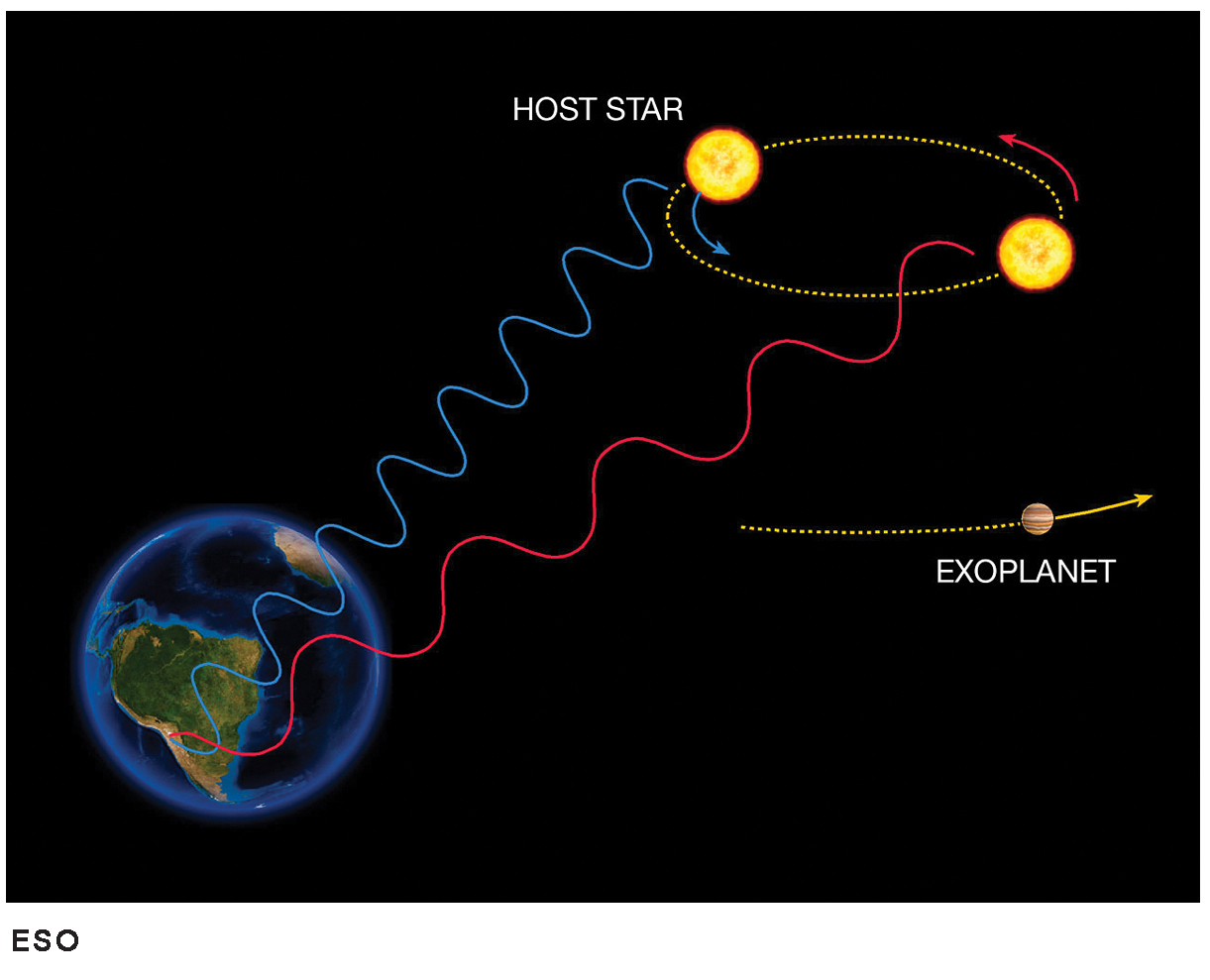
Detecting these tiny shifts requires extraordinarily careful measurements and painstaking data analysis, but it is tremendously fruitful. Since 1995, astronomers have used the radial velocity method to discover more than 500 exoplanets from ground-based observatories, and this same strategy is used to confirm suspected exoplanets identified by the transit method, described above.
109
Microlensing by Extrasolar Planets
In 2004 astronomers began to use a property of space discovered by Albert Einstein as a tool for detecting extrasolar planets. Einstein’s general theory of relativity makes the remarkable statement that a star’s gravity can deflect the path of a light beam just as it deflects the path of a planet or spacecraft. If a star drifts through the line of sight between Earth and a more distant star, the closer star’s gravity acts like a lens that focuses the more distant star’s light. Such microlensing causes the distant star’s image as seen in a telescope to become brighter. If the closer star has a planet, the planet’s gravity will cause a secondary brightening whose magnitude depends on the planet’s mass (Figure 4-21). Using this technique, astronomers have detected a handful of extrasolar planets at distances up to 21,000 ly and expect to find many more.
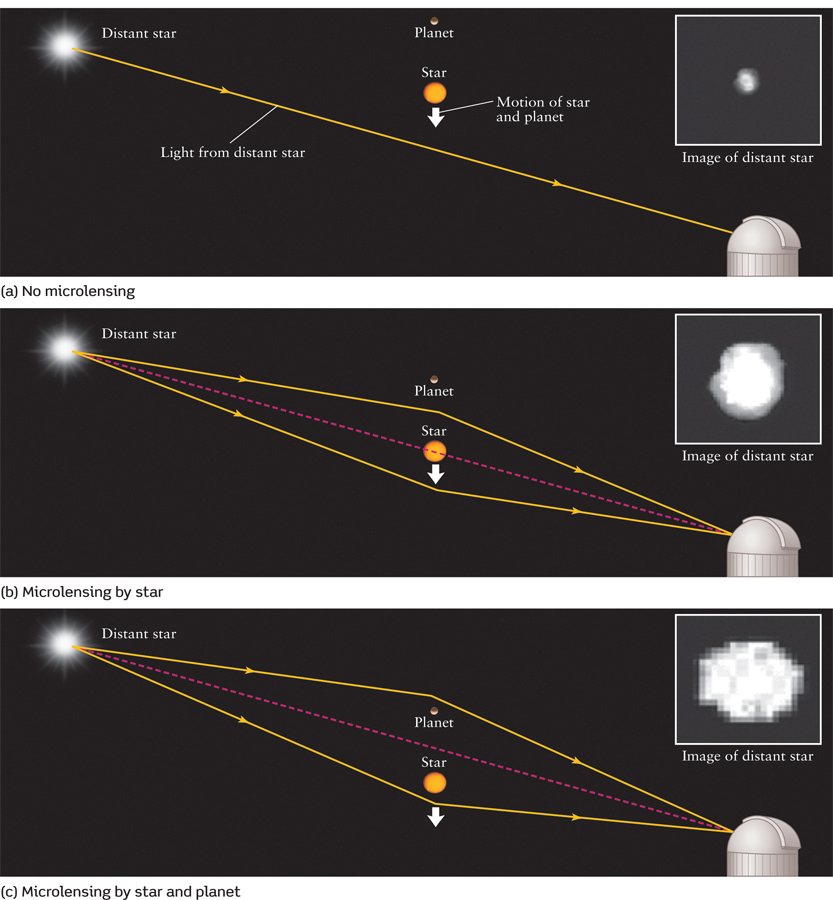
110
This microlensing technique has only discovered a confirmed 19 exoplanets as of this writing, but this number came from observations covering only a very small portion of the sky. If 19 planets were discovered in just one small region of the sky, astronomers estimate that there could be more than 100 billion planets orbiting stars in our Galaxy alone—an average of about one planet per star, which is the largest estimate ever calculated (Figure 4-22).

Question
ConceptCheck 4-17: Why will the radial velocity method fail to discover an extrasolar planet if the extrasolar planet’s orbit is oriented perpendicular to the line between Earth and the wobbling star?
Question
CalculationCheck 4-4: How long would the transit last if the star was only half as wide but with the same mass?
111